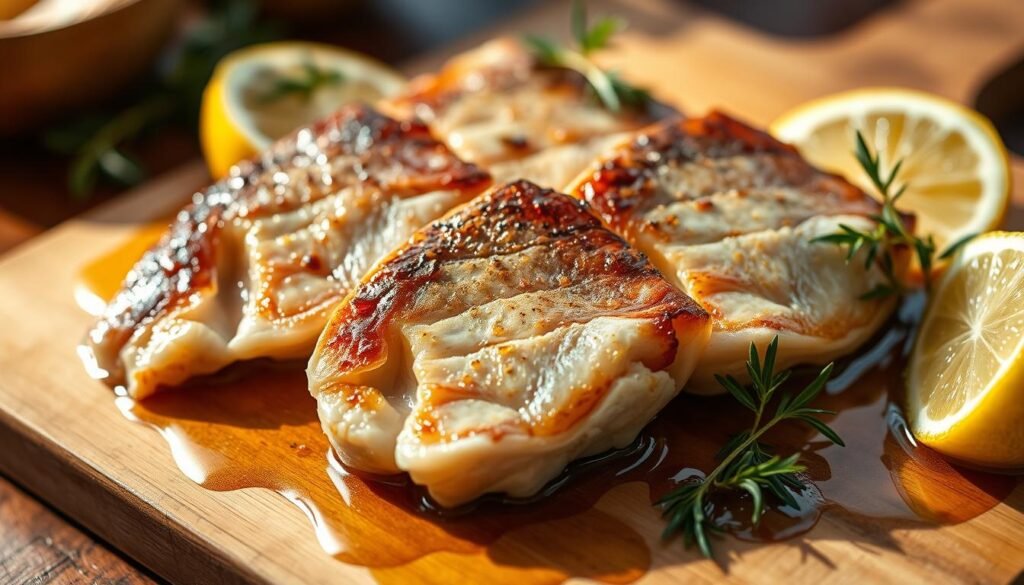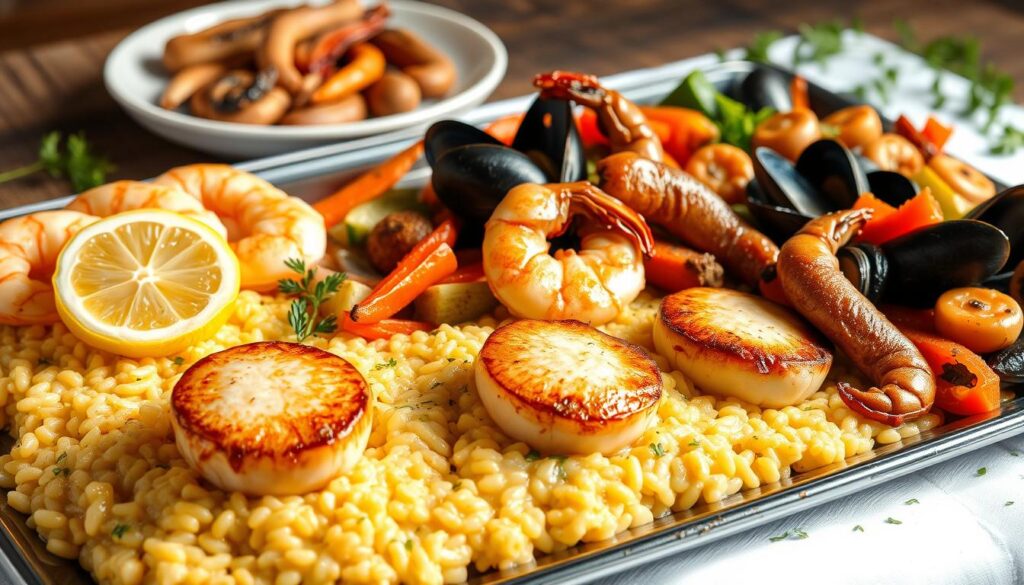The Best Fluffy Pancakes recipe you will fall in love with. Full of tips and tricks to help you make the best pancakes.

Imagine being at a traditional Asian dinner, surrounded by seafood’s rich flavors and aromas. Fish, cheeks are a big deal in many Asian cultures, especially at special times. They offer a unique taste and texture that seafood lovers should try.
In the U.S., you can find fish, cheeks in many Asian restaurants. This shows how diverse seafood is in different cultures. Amy Tan’s “Fish, Cheeks” tells us how important it is to keep our cultural traditions alive, including our food.
Exploring fish, cheeks takes you into the heart of Asian cuisine and its growing fame in the U.S. With its rich flavor and texture, fish cheeks are a great choice for seafood lovers. They add a special touch to any meal.
Table of Contents
Understanding the Delicacy of Fish Cheeks
Fish, cheeks are a popular dish in Asian cuisines. They are seen as a delicacy and are often served at special events. In many cultures, this dish is linked to good fortune and prosperity.
Cooking fish, cheeks is simple. They can be pan-seared or baked. It’s important not to overcook them to keep them tender. The right cooking method brings out their flavor and texture.
In many Asian cultures, fish, cheeks are a luxury food served to special guests. Paired with soy sauce and ginger, they create a flavorful dish. The recipe can vary, but the ingredients are always the same. With the right cooking and ingredients, fish, cheeks are a memorable dish for any occasion.
What Are Fish Cheeks?
Fish, cheeks come from larger fish like Alaskan halibut and grouper. They are harvested in small amounts, making them rare and valuable. Known for their tender texture and flavor, they are similar to sea scallops.
Why They’re Considered a Delicacy
Fish, cheeks are rare and have a unique flavor. They are served on special occasions and are a luxury food in many cultures. In Asian cuisines, they symbolize good luck and prosperity.
Cultural Significance Across Cuisines
The cultural meaning of fish, cheeks varies but often relates to good fortune and prosperity. In many Asian cultures, they are served at weddings and holidays. With the right recipe and cooking, fish, cheeks are a delicious and memorable dish, appreciated by all who try them.
The Rich History Behind Fish Cheeks in Global Cuisine
Fish, cheeks have a long history in global cuisine, with roots in Asia. Amy Tan’s short story “Fish, Cheeks” shows how food ties Chinese-American families together.
In many Asian cultures, fish, cheeks are a delicacy. In Japan, they’re served as sashimi. In China, they’re stir-fried with veggies and noodles. The way they’re prepared and eaten shows their cultural importance.
Amy Tan believes food shapes cultural identity. Her story “Fish, Cheeks” tells of a Chinese-American girl’s cultural pride at a Christmas dinner. It shows how food bridges cultural gaps.
The history of fish, cheeks is rich and varied. Different cultures have their ways of enjoying them. Whether as sashimi or stir-fried, fish cheeks are loved worldwide.
| Culture | Traditional Dish |
|---|---|
| Japanese | Sashimi |
| Chinese | Stir-fry with vegetables and noodles |
In conclusion, fish, cheeks’ history shows the power of traditional food. Amy Tan’s “Fish Cheeks” reminds us of food’s role in preserving culture and fostering understanding.
Nutritional Benefits of Fish Cheeks
Fish, cheeks are a nutritious and healthy food option. They are rich in protein and essential nutrients. They also have omega-3 fatty acids, which are good for your heart and brain.
A 3-ounce serving of halibut has about 20 grams of lean protein. This makes it a great choice for increasing your protein intake. The American Heart Association suggests eating fish high in Omega-3s at least twice a week. This can help lower the risk of heart disease.
Some of the key health benefits of fish, cheeks include:
- High in protein and omega-3 fatty acids
- Low in calories and fat
- Rich in essential vitamins and minerals, such as vitamin B12, selenium, and magnesium
Fish, cheeks are a nutritious and delicious addition to any meal. They can be prepared in many ways, like grilling, baking, or pan-searing. They are perfect for any seafood lover looking to try a new recipe.
Best Fish Species for Cheek Meat
Choosing the right fish for cheek meat is key. Fish cheeks are a delicacy in many cuisines. Salmon, cod, and halibut are top choices because they’re high in fat. This makes their cheeks tender and flavorful.
Other good options include tilapia and mahi-mahi. They might need more cooking to get the right texture. But, the right species can make any dish special. Fish, cheeks are rare and prized, adding a unique touch to any meal.
In the world of seafood, fish, cheeks stand out. They offer a rich flavor and firm texture. By picking the right fish, you can make unforgettable dishes. So, why not try fish, cheeks? They’re sure to become a favorite in your kitchen.
| Fish Species | Flavor Profile | Texture |
|---|---|---|
| Salmon | Mildly sweet | Firm |
| Cod | Flaky | Tender |
| Halibut | Rich | Firm |
How to Select and Purchase Fresh Fish Cheeks
When looking for fresh fish cheeks, there are key things to check. They should smell good, be firm, and look fresh. You can find them at seafood markets, some supermarkets, or online from trusted suppliers.
A top seafood market will offer many fresh fish cheeks. The staff can tell you about the fish’s origin and freshness. Choose fish cheeks in sealed packages or on ice to keep them fresh longer.
What to Look For
- Freshness: Look for fish cheeks that have a pleasant smell and are firm to the touch.
- Origin: Check the origin of the fish cheeks to ensure that they are sustainably sourced.
- Storage: Make sure that the fish cheeks are stored properly, either in a sealed package or on a bed of ice.
Where to Buy
Fresh fish cheeks are available at seafood markets and some supermarkets. You can also buy them online from trusted suppliers. Here are some popular places:
| Supplier | Location | Price |
|---|---|---|
| Seafood Market | Local | $15/lb |
| Online Supplier | National | $20/lb |
By following these tips, you can find and buy fresh fish cheeks for your next cooking or recipe project.
Essential Preparation Techniques for Fish Cheeks
Cooking fish cheeks requires some key techniques. You can bake, grill, or sauté them, making them perfect for many dishes. First, preheat your oven to 400°F (200°C) for baking. Or, heat a pan with oil over medium-high heat for sautéing.
Fish cheeks usually need 10-12 minutes in the oven or 2-3 minutes per side in a pan. The cooking time can change based on the cheeks’ thickness. So, keep an eye on them to avoid overcooking. For a crispy outside and soft inside, try frying them in about 1 inch of oil. Use a recipe with ½ cup of oil and your favorite seasonings, like Old Bay or garlic powder.

- Baking: a low-fat and healthy option that helps retain the delicate flavor of the fish
- Grilling: adds a smoky flavor and a crispy texture to the cheeks
- Sautéing: a quick and easy method that works well with a variety of seasonings and sauces
When using a recipe, adjust the cooking time and method based on the fish cheeks type and your preference. With these techniques and a bit of practice, you’ll make tasty and memorable dishes with fish cheeks.
Fish cheeks are a delicacy that can be prepared in a variety of ways, making them a great ingredient for experimenting with new recipes and cooking techniques.
Classic Fish Cheek Recipes from Around the World
Fish cheeks are a special treat in the world of seafood. They bring a unique taste and texture to any dish. With the right recipe, you can make a dish that looks and tastes great. Learning to cook fish cheeks takes practice, but it’s worth it.
In many places, fish cheeks are a favorite in seafood dishes. In Asia, they’re often stir-fried with veggies and noodles, or in soups with tofu and seaweed. In the Mediterranean, they’re grilled or baked, served with lemon and herbs.
Asian-Style Fish Cheeks
The Asian-style stir-fry is a popular way to enjoy fish cheeks. It combines fish cheeks, veggies, and noodles in a quick-cooking wok or skillet. The secret is to cook everything fast over high heat, making the outside crispy and the inside tender.
Mediterranean Preparations
In the Mediterranean, fish cheeks are cooked with simple yet flavorful ingredients. They’re seasoned with lemon, herbs, and olive oil. This method highlights the fish’s natural taste, making for a tasty and healthy seafood dish.
| Recipe | Ingredients | Cooking Time |
|---|---|---|
| Asian-Style Fish Cheeks | Fish cheeks, vegetables, noodles | 10-15 minutes |
| Mediterranean Fish Cheeks | Fish cheeks, lemon, herbs, olive oil | 10-12 minutes |
These recipes and cooking methods let you make tasty seafood dishes with fish cheeks. Whether you like Asian-style or Mediterranean flavors, there’s a recipe for you to try.
Common Cooking Mistakes to Avoid
When cooking fish cheeks, there are a few mistakes to steer clear of. One key thing is controlling the temperature. If it’s off, you might end up with overcooked or undercooked fish cheeks. This can make the texture unpleasant.
To fix this, cook the fish cheeks at the correct temperature. Use a thermometer to check the accuracy.
Seasoning is another area where mistakes can happen. It’s easy to add too much salt or not enough flavor. Start with a small amount of seasoning and taste as you go. This way, you can adjust the flavors to your liking.
Don’t forget about the cooking time. Fish cheeks cook quickly, so keep an eye on them. They should be cooked just until they’re opaque and flake easily with a fork.
Lastly, don’t overcrowd the pan. This can lower the cooking temperature and make the fish cheeks cook unevenly. Cook them in batches if needed, to ensure even cooking.
By avoiding these common mistakes, you can enjoy perfectly cooked fish cheeks every time.
Pairing Suggestions and Side Dishes
Enjoying fish cheeks is better with the right pairings and side dishes. Fish cheeks can be paired with many ingredients for a unique taste. Try them with steamed veggies like asparagus or broccoli and a squeeze of lemon.
There are many ways to cook fish cheeks to match your favorite sides. You can go for something classic or try something new. Pair them with quinoa or rice and some fresh herbs for extra flavor.

- Grilled or roasted veggies like Brussels sprouts or carrots
- Sautéed greens like spinach or kale
- Mashed or sweet potatoes
- A fresh salad with mixed greens and a light vinaigrette
Have fun and be creative in the kitchen. With practice, you’ll soon be a pro at cooking fish cheeks. Enjoy them with your favorite sides.
| Side Dish | Pairing Suggestion |
|---|---|
| Steamed Asparagus | Grilled Fish Cheeks with Lemon Butter |
| Roasted Vegetables | Pan-Seared Fish Cheeks with Herbs |
| Quinoa or Rice | Baked Fish Cheeks with Soy Sauce and Ginger |
Sustainable Fishing and Responsible Consumption
Exploring seafood means thinking about its impact on our oceans. Sustainable fishing and eating responsibly are key to keeping our oceans healthy. Look for seafood that’s certified as sustainably caught or farmed, like wild-caught salmon or farmed shrimp.
Choosing sustainable seafood helps reduce the seafood industry’s environmental impact. It supports healthy fishing practices. Also, pick seafood low in mercury and pollutants, like sardines or anchovies. Responsible consumption is vital for seafood’s long-term sustainability.
Environmental Impact
The seafood industry greatly affects the environment, with a lot of waste. But, some places, like Josh Niland’s Saint Peter, are changing this. They use 91% of each fish, wasting only the parts they can’t use.
Choosing Sustainable Options
Here are some sustainable seafood choices:
- Wild-caught salmon
- Farmed shrimp
- Sardines
- Anchovies
These options are tasty and good for the planet. By picking sustainable seafood, you support responsible fishing and help prevent overfishing.
| Seafood Option | Environmental Impact | Sustainability |
|---|---|---|
| Wild-caught salmon | Low | High |
| Farmed shrimp | Medium | Medium |
| Sardines | Low | High |
| Anchovies | Low | High |
By choosing wisely and supporting sustainable fishing, you can enjoy seafood while protecting our oceans.
Conclusion: Embracing the Unique Flavor of Fish Cheeks
Start your cooking adventure by trying fish cheeks. These seafood treasures are often ignored but add a rich, tender texture to any dish. They’re perfect for both experienced chefs and home cooks looking to wow their guests.
Fish cheeks can be prepared in many ways, from Asian dishes to Mediterranean classics. Try baking, grilling, or sautéing them to bring out their best flavors. Pair them with the right sides and sauces for a meal that celebrates the ocean’s bounty.
When enjoying fish cheeks, choose sustainable sources. This helps protect our oceans while you savor their delicious taste. Begin this tasty journey and see how versatile and amazing fish cheeks can be.
FAQ
What are fish cheeks?
Fish cheeks are a special part of the fish, near the gills. They are loved for their rich taste and soft texture. Many Asian cultures see them as a delicacy.
Why are fish cheeks considered a delicacy?
They’re often served at big events like weddings and holidays. In many Asian cultures, they bring good luck and prosperity. They’re also a luxury food in some places.
What is the cultural significance of fish cheeks?
Fish cheeks are linked to good fortune and prosperity across different cuisines. In some cultures, they’re a treat for special guests.
What are the nutritional benefits of fish cheeks?
Fish cheeks are packed with protein and nutrients. They’re full of omega-3 fatty acids, which are good for your heart and brain. Plus, they’re low in calories and fat, making them a healthy choice.
What are the best fish species for cheek meat?
Salmon, cod, and halibut are top choices for cheek meat. Their high-fat content makes them tender and tasty. Tilapia and mahi-mahi are also good but might need more cooking time.
How can I select and purchase fresh fish cheeks?
Look for fresh fish cheeks in sealed packages or on ice. They should smell good and feel firm. You can find them at seafood markets, some supermarkets, or online from trusted suppliers.
What are some common mistakes to avoid when cooking fish cheeks?
Avoid overcooking and not controlling the temperature. Also, don’t season with salt or neglect adding enough acid. Cooking at the right temperature and seasoning lightly is key.
How can I pair fish cheeks with side dishes and ingredients?
Fish, cheeks go well with steamed veggies, quinoa, or rice. Add a drizzle of soy sauce or lemon juice for flavor. For a fancy dish, try them with truffles, caviar, or a creamy sauce.
Why is sustainable fishing and responsible consumption important?
Sustainable fishing and responsible seafood choices are crucial for our oceans and environment. Look for certified sustainable seafood and choose low-mercury options. Making these choices helps the seafood industry and supports healthy fishing practices.









